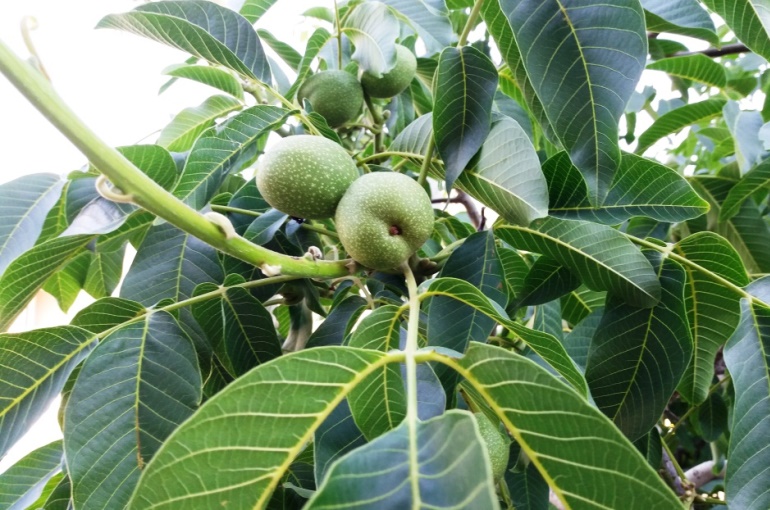Walnut Tree Fertilizer Requirements

This post is also available in:
This post is also available in:
![]() Español (Spanish)
Español (Spanish) ![]() Français (French)
Français (French) ![]() Deutsch (German)
Deutsch (German) ![]() Nederlands (Dutch)
Nederlands (Dutch) ![]() العربية (Arabic)
العربية (Arabic) ![]() Türkçe (Turkish)
Türkçe (Turkish) ![]() 简体中文 (Chinese (Simplified))
简体中文 (Chinese (Simplified)) ![]() Italiano (Italian)
Italiano (Italian) ![]() Ελληνικά (Greek)
Ελληνικά (Greek) ![]() Português (Portuguese (Brazil))
Português (Portuguese (Brazil))
How to fertilize English and Black Walnut Tree
Contemporary commercial walnut farming practices suggest that once a year (on summer, July- August) we should collect at least 100 leaves from our trees and send them to laboratory for a detailed nutrient analysis. If we detect that the average leaf has some nutrient deficiencies (some important chemical elements are below acceptable standards), then we can intervene and correct the nutrient problems by consulting an agronomist and adding the proper element, for instance a zinc amendment, through foliar application. (In most cases, copper, zinc and boron foliar applications are made after harvesting).
The normal levels of the most important nutrient are listed below:
Minimum acceptable leaf levels (when collected during summer)
N: 2.1%
P, Na: 0,1%
K: 1%
Ca: 1%
Mg, Cl: 0,3%
Z and B: 20 ppm
Cu: 4 ppm
As far as young walnut trees are concerned, in most cases minimum fertilization is required. Many farmers apply 4 oz. (113 gr) of N-P-K 15-15-15 fertilizer per every young tree, spread in two different applications, one during late spring and the other during summer. The trees must be watered after soil fertilization is applied. Alternatively, fertigation (injection of water soluble fertilizers in the irrigation system) may be suitable.
In general, walnut trees have great needs mainly in Nitrogen, and secondly in Phosphorus and Potassium. Many commercial walnut farmers add 1300 lbs. (589 kg) ammonium sulfate (ΝΗ4)2SΟ4 per hectare every year. Keep in mind that 1 hectare = 2,47 acres = 10.000 square meters and 1 ton = 1000 kg = 2205 lbs. They also add 1000 lbs. (454 kg) of P2O5 and 500 lbs. (227 kg) of Potassium sulfate (K2SO4) per hectare every 3 years. These quantities are often spread in 2-3 applications, starting during early spring and ending during autumn. However, these are just some common practices applied on mature walnut orchards and should not be followed without making your own research. Keep also in mind that –especially when adding large quantities of N- there is an increasing need to frequently check soil pH and add lime in order to raise it to suitable levels.
Excellent fertilization of mature walnut trees can be managed by adding manure. Many farmers add 10 to 20 tons of manure per hectare every one or two years. When they cannot find manure at a reasonable price, many farmers apply green manure, mainly legumes. In this case, walnut growers sow legumes in the autumn. During the next few months, they add phosphorus and potassium to the field in order to help legumes grow quickly. They finally plow the plants, incorporating them into the soil just before their flowering (spring – April , May). Keep in mind that during the decomposition of organic matter, there is increased nitrogen consumption. Consequently, many farmers add -at the time of plowing- nitrogen (in nitrate form) to the soil so as to avoid any nitrogen deficiency (ask a licensed agronomist).
However, these are just common practices that should not be followed without making your own research. Every field is different and has different needs. Checking the soil nutrients and pH is vital before applying any fertilization method. Leaf analysis is very important in order to diagnose and correct nutrient deficiencies in walnut tree, always after consulting a certified agronomist.
You can enrich this article by leaving a comment or photo of your walnut tree fertilization methods.
2.) How to grow Walnut Tree from nuts
4.) Walnut Tree Climate Requirements
5.) Walnut Tree Soil Requirements & Preparation
6.) Walnut Tree Propagation & Pollination
7.) Planting Walnut Trees – Number of Walnut Trees per Acre
8.) Walnut Tree Pruning and Thinning
9.) Walnut Tree Water Requirements
10.) Walnut Tree Fertilizer Requirements
11.) Walnut Tree Harvest & Yields
12.) Walnut Tree Diseases & Pests
14.) Wholesale walnuts online – Current Walnut Prices
Do you have experience in Walnut Tree cultivation? Please share your experience, methods and practices in the comments below. All the content you add will be soon reviewed by our agronomists. Once approved, it will be added to Wikifarmer.com and it will influence positively thousands of new and experienced farmers across the world.








































































